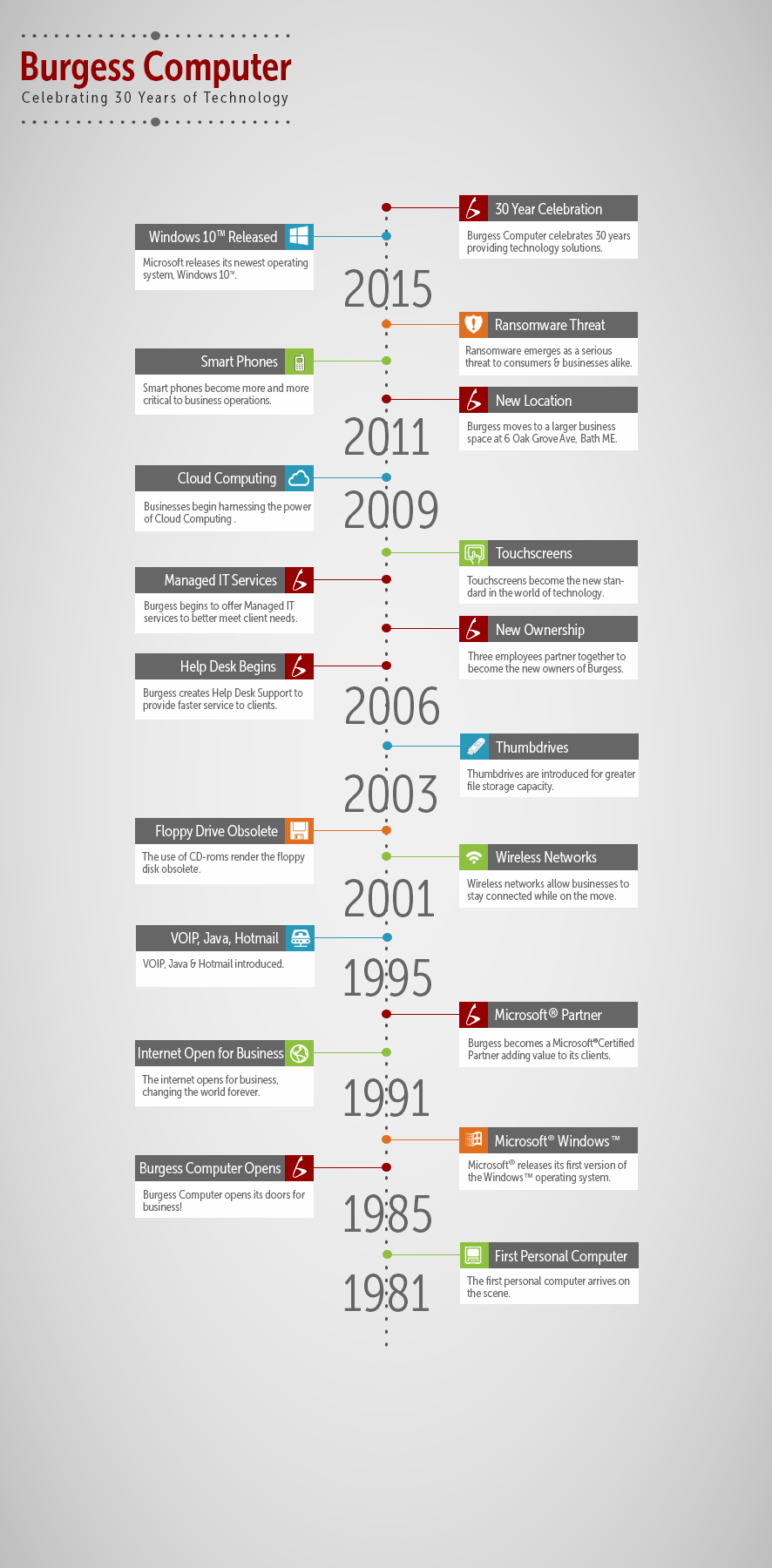30 Years of Technology
As Burgess Computer celebrates 30 years of business, I’ve reflected on the significant changes technology has undergone – particularly in my era. I entered the technology field in 1996, although I had been dabbling all through high school previous to that. One of the first topics I studied in college was something called “Moore’s Law”. In 1975, Gordon Moore wrote a paper predicting the growth of computing hardware. In essence, he projected computing technology would double in capacity and speed every two years. Gordon, a co-founder of Intel and Fairchild Semiconductor, was absolutely right. As chip speeds increased, improvements and innovations around other technologies followed. A lot of these changes have had a significant impact on society, such as social media and smartphone technology.
Technology of Data Storage
The first noteworthy advancement I can recall was the CD-ROM drive. Some of you may remember floppy disks – those flimsy 3.5” plastic things you inserted into a computer to install a program or save your files. Floppy disks didn’t hold a lot of data, and were quickly outpaced by our needs. Since they used a magnetic media, they were also prone to failure. Then came the CD-ROM. Although these were in use during the 80’s, they weren’t commonplace in computers until the mid to late 90’s. Having experienced the frustrations of using floppy disks, the CD was a marvel of technology. No longer did I need to insert disk 3 of 15 during a software installation, one CD held enough data to complete my task. The speed at which I could install the latest game meant more time playing, and less time listening to the rhythmic reading of magnetic media. Then CD-R’s came along and I could make my own mix tape (yes, even on a CD – I still call it a mix tape). By 2002, the floppy disk was obsolete. If you miss the days of the floppy, you can still hear their song at this link; https://www.youtube.com/watch?v=dmoDLyiQYKw
Download Capabilities
Everyone can appreciate the sound of a dial-up modem. Its electronic screech sounded like nails on a chalkboard. Mom and dad didn’t have a chance in hell to make a phone call if I was home, as the modem used the only phone line in the house. When I first started working in the computer shop, we had 6 phone lines – one for each bench. Each computer needed its own connection. After a lightning storm, we’d replace dozens of modems, as they were very sensitive to surges. In fact, a lightning strike miles away could travel through the phone line and zap a modem. 56k was the fastest speed you could get locally, if you were lucky. Even then, some graphic intensive webpages took minutes to download. When high-speed internet came along, it was mind blowing. With speeds hundreds of times faster, and the capability to share that connection among many computers, modems became obsolete. High-speed internet simplified connections. You didn’t have to wait for the modem to dial and connect. You didn’t need a phone line. You just clicked and boom – you were watching the hamster dance. While the original hamster dance webpage is long lost, you can still relive the song here; https://www.youtube.com/watch?v=Q6TzAQXVpB8
Internet and Wireless Connectivity
High speed internet impacted more than just web browsing. More often than not, purchasing a software package today takes you to a site where you download the files. Back in the day, you had to wait for the software to be delivered by UPS or FedEx. Some people would make copies of the installation disk and distribute them among friends. Most software now requires activation – using the internet – to make sure you’re not using a pirated copy. High-speed internet also changed how we view media. Movies delivered though Netflix and other providers changed the landscape, putting DVD rental companies out of business. This wouldn’t have been possible without the bandwidth available now.
Around 2005 Wi-Fi connectivity took mobile technology to the next level, allowing laptops and desktops to connect to the network without a cable. It was the coolest thing to be able to surf the web from your couch. We didn’t worry about security, after all it was so new very few people used it. It was also extremely slow. Todays wireless speeds are almost as fast as a cabled connection, and almost every business uses wireless in some capacity.
Mobile Technology
My first cell phone was a Nokia. It was about the size of a brick, and weighed as much too. It was expensive, but I was the only one in my crowd who had one. Then I lost it at the Topsham Fair. I called the phone company to find out if anyone had turned it in. Unfortunately, I never saw it again – a very expensive lesson. Today, I can use the web to locate my phone through GPS – even if it’s only outside buried in a snowbank or stuffed down between the couch cushions. Modern phones are smarter, smaller, have better battery life and improved call quality. And the screens….you TOUCH them to manipulate icons. 10 years ago, that was cutting edge and wildly expensive.
Along with all the good changes I’ve seen, there’s also the bad. Viruses weren’t really a problem, at the most they caused a nuisance. Malware hadn’t even been invented. Information wasn’t at risk like it is today, and network security was a second thought. As technology continues to advance, the next decade will undoubtedly focus on securing our information. Legislation and law will need to accompany technology growth at the same pace in order to ensure privacy, protection and safety. And I just read an article about Samsung patenting a roll-up phone using a flexible display. Maybe my kid’s first mobile phone will be like that! http://money.cnn.com/gallery/technology/2015/08/18/coolest-inventions-2015/5.html


Reader Interactions